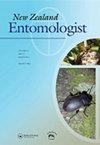Neocypholaelaps novaehollandiae Evans (Acari: Ameroseiidae) rediscovered: experiments on its life history and behaviour
IF 0.4
4区 农林科学
Q4 ENTOMOLOGY
引用次数: 12
Abstract
Members of Neocypholaelaps are pollenophagous and phoretic on a range of hosts. In New Zealand, Neocypholaelaps novaehollandiae Evans have been previously collected on native bellbirds and honeybees. The lack of information about this species triggered our interest in its life history and behaviour. We sampled mites from flowers of the nīkau palm (Rhopalostylis sapida), and subjected female mites (isolated in cells) to different diet treatments to determine the diet effects on mite survival. The survival of N. novaehollandiae was a maximum of 18 days in control to 33 days and 29 days on a diet of reed pollen and honey solution, respectively. We paired 20 males and females together in individual Eppendorf tubes and compared this with 20 single females in individual Eppendorf tubes. We demonstrated that unpaired females did not lay eggs but paired females oviposited in their cells, proving that mating is required for oviposition. We observed that six out of 10 samples contained only females (based on 2012 field surveys and preserved specimens in the New Zealand Arthropod Collection, NZAC). In samples with males, an incredibly female-biased sex ratio was found from both sources; 8.33% and 7.70% of males in two samples from the NZAC, and 2.42% and 13.10% of mites in two field samples. We observed that males display exceptional sexual dimorphism; in particular, the enlarged hind legs, which suggests male–male competition. We also report the first coleopteran host association of N. novaehollandiae with the endemic giraffe weevil (Lasiorynchus barbicornus). Further research is needed to understand the sexual dimorphism, extreme sex ratio and the genetic mating system of this species.新蚜螨(蜱螨亚纲:Ameroseiidae)的重新发现:生活史和行为的实验
新孢子虫的成员在一系列寄主上是食花粉和吸花粉的。在新西兰,Neocypholaelaps novaehollandiae Evans曾在当地的风铃鸟和蜜蜂身上被采集到。由于缺乏关于这个物种的信息,我们对它的生活史和行为产生了兴趣。本研究采集了nnk kau palm (Rhopalostylis sapida)的花螨,并对细胞内分离的雌性螨进行了不同的饮食处理,以确定饮食对螨存活的影响。以芦苇花粉和蜂蜜溶液为食,新荷兰乳杆菌的存活时间分别为33天和29天。我们将20只雄性和雌性在单独的埃彭多夫管中配对,并将其与20只雌性在单独的埃彭多夫管中进行比较。我们证明了未配对的雌性不产卵,但配对的雌性在它们的细胞中产卵,证明了交配是产卵的必要条件。我们观察到10个样本中有6个只含有雌性(基于2012年的实地调查和新西兰节肢动物收藏的保存标本)。在男性样本中,两个来源都发现了令人难以置信的女性偏向性比例;NZAC 2份样本中,雄螨率分别为8.33%和7.70%,野外2份样本中,螨率分别为2.42%和13.10%。我们观察到雄性表现出特殊的两性二态性;尤其是后腿变大,这表明了雄性之间的竞争。我们还报道了新荷兰奈蚊与特有的长颈鹿象鼻虫(Lasiorynchus barbicornus)的首次鞘翅目宿主关联。该物种的两性二态性、极端性别比和遗传交配系统有待进一步研究。
本文章由计算机程序翻译,如有差异,请以英文原文为准。
求助全文
约1分钟内获得全文
求助全文
来源期刊

New Zealand Entomologist
ENTOMOLOGY-
CiteScore
0.70
自引率
33.30%
发文量
3
审稿时长
>12 weeks
期刊介绍:
The invertebrate diversity of New Zealand is of great interest worldwide because of its geographic isolation and geological history. The New Zealand Entomologist plays an important role in disseminating information on field-based, experimental, and theoretical research.
The New Zealand Entomologist publishes original research papers, review papers and short communications. We welcome submissions in all aspects of science regarding insects and arthropods in a New Zealand or Australasian setting. The journal’s subject matter encompasses taxonomy, phylogenetics, biogeography, biological control and pest management, conservation, ecology and natural history.
The journal is the official publication of the Entomological Society of New Zealand. Papers published or submitted elsewhere for publication will not be considered, but publication of an abstract or summary elsewhere (e.g. conference proceedings) does not preclude full publication in the New Zealand Entomologist. Accepted papers become copyright of the Entomological Society of New Zealand. The journal is published in English, but we also welcome publication of abstracts in Maori.
 求助内容:
求助内容: 应助结果提醒方式:
应助结果提醒方式:


